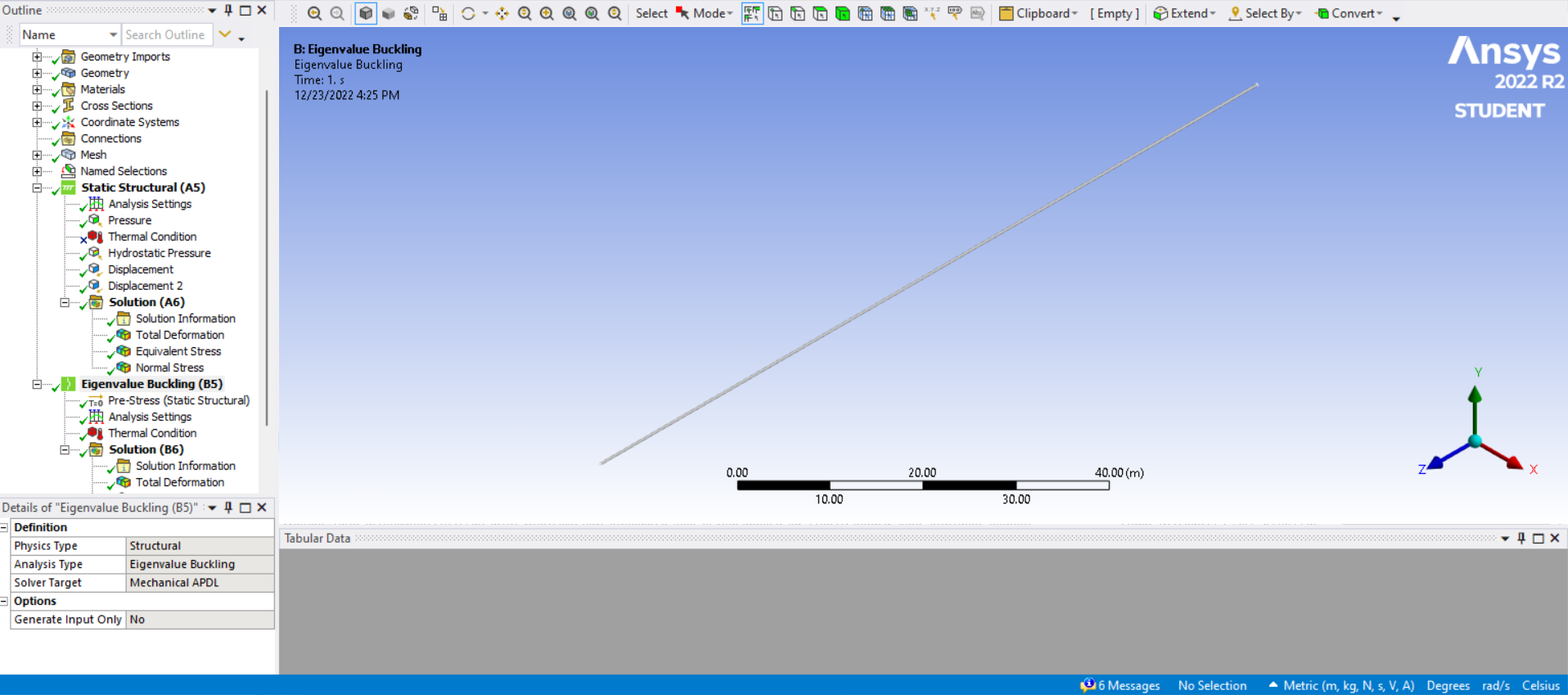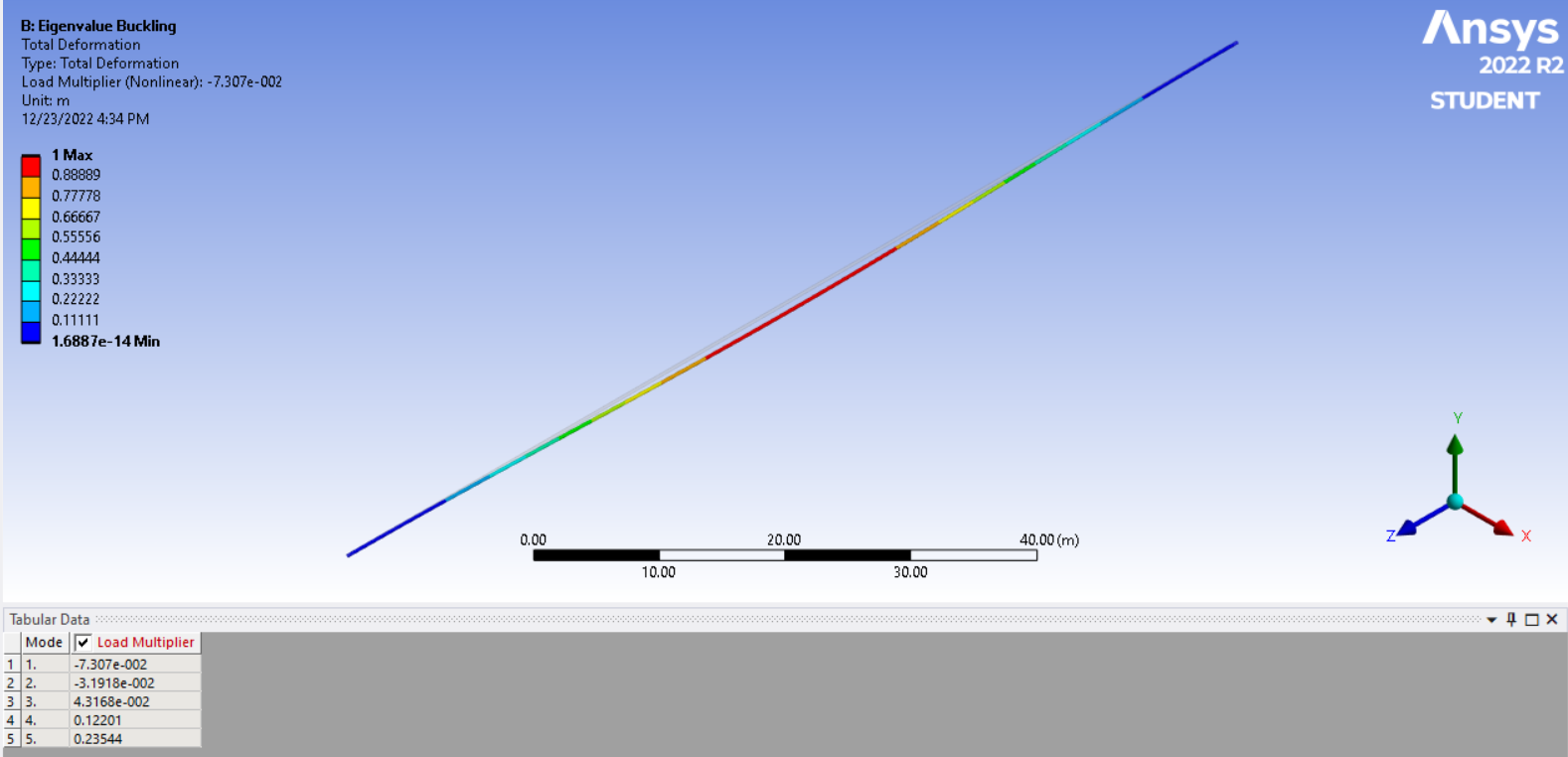-
-
December 23, 2022 at 8:57 am
Adrian Lim
SubscriberGreetings,
I'm new to Ansys and currently working on a pipeline buckling analysis under High Temperature High Pressure condition and I'm unsure of the direction and approach of the simulation is right. Here is what I have come up so far, I've modelled a 3D cross section pipe and implied 20MPa pressure normal to the internal surface on the pipe and a hydrostatic pressure simulating the pipe is on a seabed surface. I have selected two end faces of the pipe as displacement constraint where they can only move in lateral directions and select all the bottoms nodes of the pipe with the same displacement constraint where they can only move in lateral and logitudinal directions (to simulate lateral buckling). The thermal condition of the pipe is then defined at 100°C under the buckling analysis. Large deflection is turned on.
- The solution is able to solve and here are the results, no matter how I increase the internal pressure/temperature, the maximum deflection remains the same(1m), is there any limitations that prevent the pipe for going further? The only changes are the multipliers and the minimum deflection value.
- How do we obtain the critical buckling stress from the load multiplier below? Understanding from Linear solutions, the multipler is factored to the applied load and we may get the critical buckling but for non-linear cases it does not seem to be the case. From the second figure below the last scenario would be what I'm having now, would my critical buckling stress be the stress applied in structural analysis (internal pressure+hydrostatic pressure)+(compressive stress caused by temperature)*multiplier?Appreciate if someone could guide me on this.
-
December 23, 2022 at 12:56 pm
peteroznewman
SubscriberHello Adrian,
For the displacement constraints in Static Structural, you say "they can only move in lateral directions" but if there is no lateral constraint on any node, that would cause a zero pivot error unless you are using Weak Springs. Please clarify.
Pay no attention to the legend in the Total Deformation plot of the Eigenvalue Buckling analysis. The deflected shape is the relevant information. This is similar to a Modal analysis, where Total Deformation is to view the shape, not the magnitude, which is arbitrary.
Pay attention to the Tabular Data which shows the load multipliers. The first positive multiplier is 0.0432 and that applies to the load you applied in the Eigenvalue analysis, which is a Temperature load. Temperature is different to a Pressure or Force load. For a force, 0 is no load, but for temperature, 0 is not no load. No load is the Enviroment Temperature. If your Environment Temperature was 20 C, then that is the no load temperature. The temperature load is an 80 C increase to get up to 100 C. I think the multiplier is on 80 and not 100. This analysis predicts buckling would occur at a 0.0432x80.0 = 3.46 C increase or a temperature of 23.46 C. The first multiplier is negative which means it predicts buckling when it gets colder than 20 C.
You seem to have read the ANSYS Help section on Eigenvalue Bucking.
For Pressure boundary conditions in the Static Structural analysis: if you define the load with the Normal To option for faces (3D) or edges (2-D), you could experience an additional stiffness contribution called the "pressure load stiffness" effect. The Normal To option causes the pressure to act as a follower load, which means that it continues to act in a direction normal to the scoped entity even as the structure deforms. Pressure loads defined with the Components or Vector options act in a constant direction even as the structure deforms. For a given pressure value in the upstream static system, the Normal To option and the Component/Vector options can produce significantly different buckling load factors in the follow-on Eigenvalue Buckling analysis.
Did you set Normal To on your pressure load?
Please show details on the Hydrostatic Pressure. For a horizontal pipe, the depth below the surface is much larger than the diameter of the pipe, so the change in hydrostatic pressure from the bottom of the diameter to the top of the diameter is insignificant.
-
December 23, 2022 at 1:02 pm
peteroznewman
Subscriber- The Total Deformation plot is to look at the shape only and the magnitude is arbitrary with a maximum of 1.
- A temperature load is applied in Buckling so if the Environment Temperature was 20 C, which is no load, then the temperature load is an increase of 80 C and you multiply that by 0.0432 to get a load of a 3.4 C increase or a temperature of 23.4 C with all the other loads applied in the Static Structural.
-
December 23, 2022 at 8:05 pm
peteroznewman
SubscriberYou say you have applied Displacement boundary conditions that leave lateral motion Free, but you can't have all the nodes Free or you would get a zero pivot error unless you have Weak Springs turned ON and you don't want that in the Static Structural that is upstream of an Eigenvalue Buckling analysis.
-
December 26, 2022 at 9:44 am
Adrian Lim
SubscriberHi Peter,
Thanks for the reply.
- Noted on that. Hence the buckling analysis in Ansys would only be able to study the shape but not the actual amplitude of the buckling?
- Got the idea of how the multiplier works, so the critical buckling load would be the total load I applied in the static structural and at 23.4°C, is that correct? Does the mutiplier shown in -ve suggests not applicable solution? Would like to do a comparison between actual buckling load from simulation and analytical solution.
- Yes I noticed it did came out as a warning and the amplitude of the pipe buckling came out differently where it is maximum at the starting and end point of the pipe. I have fixed the total deplacement at the starting and end of pipe and the result makes more sense.
-
-
December 26, 2022 at 1:32 pm
peteroznewman
Subscriber1. Eigenvalue Buckling is a solution to determine the critical load when buckling occurs and the shape it would take after buckling. It is not to determine the amplitude of the buckling. Use a nonlinear (large deflection) Static Sructural analysis to determine the deformation post-buckling.
2. A negative load multiplier means that there is a buckling solution in the other direction from the applied load. If the load was a compression force, that means the struture could buckle in tension. For temperature if the load was to increase the temperature, that means the structure could buckle when it gets cooler. Sometimes these mathematical solutions make sense, and sometimes they don't.
3. When you created a Fixed Support, at one end, what was the new load multipliers? You have to recalculate the temperature if they changed. Also, try applying the temperature load of 23.4 C (or whatever the new number is) and see if the Load Multiplier comes out close to 1.0
-
December 26, 2022 at 3:56 pm
Adrian Lim
SubscriberHi Peter,
- When I study the nonlinear deflection in static structural, it doesn’t show any of the deflections due to the constraints. May I know how do I setup the post-buckling analysis?
- Understood on that, but if I were to compare the numerical and analytical results, would it be better if I move all the parameters to buckling analysis? Since the multiplier only affects the temperature. Don’t really understand what is the correlation between them.
- I did plug in the new numbers and the load multipier does get close to 1!
-
-
December 26, 2022 at 9:02 pm
peteroznewman
SubscriberDid you take the free course on Linear Buckling?
The free course on Structural Instabilities includes a nonlinear buckling homework problem.
The geometry in the nonlinear static structural problem must be seeded with a small percentage of the buckled shape to get the structure to buckling in that way.
If you read the ANSYS Help on Pre-stressed Eigenvalue Buckling, it makes it clear that only the loads applied in the Eigenvalue Buckling are included in the solution that has a Load Multiplier. All the loads applied in the Static Structural only serve to affect the stiffness matrix sent to the Buckling solver. Did you read the help section on different ways to define how Pressure can be applied? That seems relevant.
-
- The topic ‘Pipeline Buckling Analysis’ is closed to new replies.


- The legend values are not changing.
- LPBF Simulation of dissimilar materials in ANSYS mechanical (Thermal Transient)
- Convergence error in modal analysis
- APDL, memory, solid
- How to model a bimodular material in Mechanical
- Meaning of the error
- Simulate a fan on the end of shaft
- Real Life Example of a non-symmetric eigenvalue problem
- Nonlinear load cases combinations
- How can the results of Pressures and Motions for all elements be obtained?

-
4102
-
1487
-
1318
-
1156
-
1021

© 2025 Copyright ANSYS, Inc. All rights reserved.









